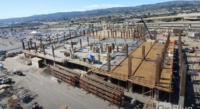

The Boston Central Artery/Tunnel project would seem to be a textbook case of a megaproject gone off the rails: Projected to cost $8 billion, the "Big Dig" ended up at $14.6 billion. The original seven-year schedule doubled, numerous indictments were handed up, and an accident killed a motorist.
The 2006 deadly collapse of 10 tons of precast-concrete ceiling panels in the I-90 connector tunnel, which killed a vehicle passenger, is the project's one, literally fatal flaw. Otherwise, the long-term positive effects are clear, say many.
In less than 10 years, CA/T has spurred billions in new economic development, including millions of sq ft of new construction and green space in the heart of the city. "I can't imagine what the city would be like now without it," says Tom Hynes, chief executive officer in the Boston office of the commercial real estate giant Colliers International.
"The scope of the project increased dramatically," he adds. "Maybe the original cost estimate was unrealistic. But the result is that it was absolutely transformative for the city and the region."
A state inspector general's report, issued in 2001, suggests that Parsons Brinckerhoff and Bechtel, the program managers, had accurately predicted the real costs in 1994 (ENR 4/2/01 p. 13). At the time, an ENR editorial noted the "blood sport" of Boston politics and stated: "Sooner or later, the U.S. will have to embark on more projects of this magnitude, and there will be a significant element of distrust at all levels over whether decision-makers are getting the straight poop on the situation. The real questions that investigators should be looking at are whether this scope of project was needed and whether the public will get its money's worth. We think that the answer ultimately will be affirmative on both counts, but the process certainly could have been better."
The program rerouted Interstate 93 out of the heart of the city into the 3.5-mile Thomas P. O'Neill Jr. Tunnel. It also entailed construction of the Ted Williams Tunnel that extends I-90 to Logan International Airport, and the Rose Kennedy Greenway, which was built in alignment with the I-93 elevated roadway, which was removed. The most iconic element of the project, the HNTB/Figg-designed Leonard P. Zakim Bunker Hill Memorial Bridge over the Charles River, is the world's widest cable-stayed bridge and a signature structure for Bunker Hill.
Hynes and Dan McNichol, author of "The Big Dig," credit the project as a huge factor in the U.S. Olympic Committee's choice of Boston as nominee for the 2024 Summer Olympic Games host. "Improvements made to Boston's transportation infrastructure by the project included converting derelict industrial properties into 600 acres of prime development space, called the Seaport District, by linking the former commercial dead zone to Logan International Airport and the interstate," says McNichol.
"Now, a system built to handle over 300,000 vehicle trips a day has replaced a highway that was built to handle 75,000 vehicle trips a day," he adds."The Big Dig pushed civil engineering into the future by deploying the biggest, first and most innovative uses of slurry-wall technology, immersed-tube tunneling and tunnel jacking."




Post a comment to this article
Report Abusive Comment